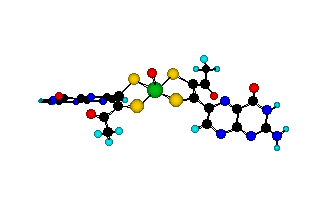

I label myself as a bioinorganic chemist and in that context, one who studies the chemistry of model compounds or synthetic mimics of the actual biological entity. Despite this inorganic label, it is in fact an organic molecule (or more accurately, class of molecules) that is the thread that ties together all of the projects of my research group. From the broadest view, I and my students have been studying the interactions between the organic nitrogen heterocyclic compounds called pterins and transition metals, where these studies have included syntheses, reactivities and spectroscopic characterizations. The landscape for these studies is a description of the function of metalloenzymes which use pterin cofactors as assistants in catalyzing the biological reactions, such as in molybdenum enzymes and the aromatic amino acid hydroxylases. In the course of this work, we have learned that metals bound to pterins have a highly covalent bonding that results in unusual electronic and spectroscopic properties.
A second research area that has been developed over the last decade in my labs concerns the synthesis of molybdenum dithiolene compounds. The goal of this project is to ultimately prepare model complexes with ligands nearly identical to those on molybdenum in the enzymes. With one exception, ours is the only research group pursuing this work with molecules designed to closely mimic the cofactor structure observed in the enzymes. These molybdenum dithiolene model compounds have structures that incorporate both the dithiolene and pterin features of the special ligand for molybdenum at the active sites of all molybdenum and tungsten enzymes. Studies of these compounds should lead to a detailed understanding of the unique aspects of the pterin-dithiolene structure influencing both the reactivity at the molybdenum and within the coordinated dithiolene ligand itself. The funded collaboration with John Enemark at Tucson and other collaborative studies planned with Martin Kirk at U. Mexico provide access to instrumentation essential for complete study of these compounds, such as Electrospray Ionization-Mass Spectrometry (ESI-MS), Resonance Raman, EPR and MCD.
Recent and On-going Projects
Transition Metal Complexes of Pterins:
v Synthesis of Transition Metal Pteridine Complexes http://www.brynmawr.edu/Acads/Chem/sburgmay/homepage/Publications/abstract.9.html
v Non-Innocent Pterin Ligands on Molybdenum: This project identified the covalent character of the Mo-pterin unit and is fully described in three papers: Part 1, Part 2 and Part 3.
v Redox Reactions and Electronic Structure of Metal-Pterin Complexes. This review summarized our work and that of others in this area. http://www.brynmawr.edu/Acads/Chem/sburgmay/homepage/Publications/abstract.4.html
v Pyranopterin Reactivity. This project has involved the study of redox reactions of the pyranopterin system, work directed to understanding similar potential reactions in all moybdenum and tungsten enzymes. Future work iis directed at complexation of the pyranopterin to Mo and its study by resonance Raman and by ESI-MS .
v Thermochromic Behavior of Metal Pteridine Complexes. This is a new collaborative study with Professor Martin Kirk of the University of New Mexico which investigates the unusual ability of some complexes to change color of with temperature. The results are directed towards design of materials with special electronic properties.
v Ruthenium Pteridine Complexes Binding to DNA: . This project that has the goal of probing possible interactions of pterin-derivatized phenanthroline complexes of ruthenium with DNA.
Molybdenum Dithiolene Complexes:
v Studies of Pterin-Substituted Dithiolene Complexes of Molybdenum, the Closest Synthetic Models to the Catalytic Site in Mo Enzymes. This project currently involves most of the research group effort. We had successfully completed the synthesis of the target complex and now, through its characterization, aim to understand the Mo site in the enzymes.
v Characterization of Mo-Pterinyl-Dithiolenes by ESI-MS. The above project is propoelled by our recent use of ESI-MS at the University of Arizona in a collaborative project with Professor John Enemark.
v Degradation Studies Of Molybdenum Dithiolenes. Our early work proved the connection between observed human metabolites of Mo-enzymes and the degradation of synthetic models complexes. (paper : http://www.brynmawr.edu/Acads/Chem/sburgmay/homepage/Publications/full%20paper.8.html)
v Understanding
the Variable Electronic Structure of Molybdenum Dithiolenes. In collaboration
with Professor Martin Kirk of the University of New Mexico, this study
aims to identify the reason for unusual magnetic propoerties of molybdenum
dithiolene complexes.
Teaching Opportunities
I am involved in teaching at many levels from freshman through graduate courses, with class sizes ranging from about 80 to 5 students. Depending upon the background and interests of the applicant, this collection of courses should provide a broad range of possible teaching experiences, including interdepartmental teaching with Geology.
Inorganic Chemistry (CHEM231). This is a junior level one-semester course required of all chemistry majors. Included in the course is a weekly five-hour lab emphasizing synthesis and instrumental methods of characterization. http://www.brynmawr.edu/Acads/Chem/sburgmay/chem231/inorganic.html
Advanced Inorganic Chemistry (CHEM332). Two topics are introduced in this senior level course?Organometallics and Bioinorganic chemistry? that illustrate the application of inorganic principles to two interdisciplinary areas of study.
Group Theory (CHEM535). This graduate course develops the group theoretical use of molecular symmetry to solve problems in bonding and spectroscopy.
Low Temperature Geochemistry (GEO302). This is an advanced level geology course that is team taught by myself and Maria Crawford (Geology).
General Chemistry (CHEM104). My usual assignment in the yearlong General Chemistry sequence is the second semester portion, the part of the course where principles and applications of equilibrium, redox and electrochemistry, acid/base chemistry and transition metal chemistry is covered.
Undergraduate Research Supervision. There is ample opportunity to gain experience supervising undergraduate research students in my research group. The applicant could expect to participate in all aspects of project design, student advising, lab maintenance and publication.